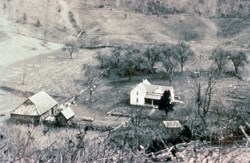
Cataloochee was once divided into two communities-- Big Cataloochee and Little Cataloochee. Big Cataloochee was situated in a large, oval shaped valley surrounded by mountains that rise between 3,000 and 6,000 feet above sea level. Noland Mountain physically separates the valleys of Big Cataloochee and Little Cataloochee, but the two communities were connected by blood and marriage.

NPS Photo For many residents, church gatherings were a very important part of their lives. Sunday school was held every week, and Sunday services were held once a month. Most of the preachers were circuit riders who only visited once a month. When a preacher was in the valley, church services were held both Sunday morning and evening. A revival was also held every fall. For the most part, Cataloochee residents were either Baptist or Methodist. 
NPS Photo School was also important to the residents of Cataloochee. Each of the three schools in the valley had a term that normally ran from November through January unless there was extra funding for a longer term. The schools followed the laws and curriculum prescribed by the state of North Carolina. Students were taught the subjects of reading, writing, spelling, arithmetic, geography and grammar. On Friday afternoons, parents would come to the schoolhouse to see how much the students had accomplished that week. For the parents, students would often have a spelling bee, recitations or singing to show-off their accomplishments. 
NPS Photo As the population of Big Cataloochee grew and the land became scare, young people of Big Cataloochee moved out of the crowded valley to build their own homes and families in Little Cataloochee. By 1910, there were around 1,251 people living in both Cataloochees, making it the largest community in the Smoky Mountains. - Written by Jen Smith Recommended Reading 
Mountain Home: A Pictorial History of Great Smoky Mountains National Park Learn about the park's history through images retelling the story of the Cherokee Indians, the European settlers, and the birth of America's most popular national park. |
Last updated: April 14, 2015
